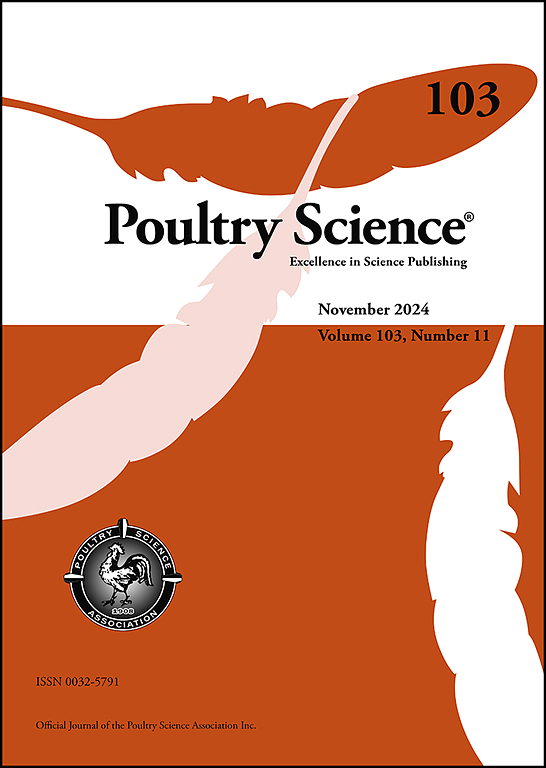Gene expression and alternative splicing reveal the co-regulation of host response mechanisms to avian leukosis virus subgroup J-infected in laying hens
IF 4.2
1区 农林科学
Q1 AGRICULTURE, DAIRY & ANIMAL SCIENCE
引用次数: 0
Abstract
Avian leukosis in China has spread from broiler chickens to the local breeds and commercial laying hens. Studying resistance to avian leukosis is important for disease-resistant breeding programs. Gene expression and different transcripts may affect immune function. In this study, we compared five naturally infected Rhode Island Red (RIR) hens carrying tumor with five uninfected individuals to explore avian leukosis virus subgroup J (ALV-J) induced differences in gene expression and alternative splicing (AS) in the liver, spleen caused. Analyses revealed 847, 80 differentially expressed genes (DEGs), along with 207, 167 differential alternative splicing genes (DASGs) in the liver, spleen respectively. Most differential splicing events involved exon skipping. Although most genes showed no significant expression changes, their protein spatial structures were altered by AS. In the liver, microtubule cytoskeleton-related functions were co-regulated by both gene expression and splicing, with CCSER2 and MAPT exhibiting the highest splicing frequency. In the spleen, splicing predominantly affected RNA-processing genes, where PKLR and SRSF7 functioned as key regulators. Notably, PKLR-interacting genes (THRSP, ADH1C, AQP3) were significantly downregulated in infected groups, potentially promoting viral replication and tumor proliferation. These findings demonstrate that AS contributes to the host response to ALV-J infection through multiple mechanisms, including protein structural remodeling and dysregulation of coordinated interaction networks. This study provides new insights into the genetic basis of ALV-J resistance in laying hens.
基因表达和选择性剪接揭示了蛋鸡对禽白血病病毒j亚群感染的宿主反应机制的共同调控
中国的禽白血病已从肉鸡扩散到地方品种和商品蛋鸡。研究禽白血病的抗性对抗病育种计划具有重要意义。基因表达和不同转录本可能影响免疫功能。本研究通过对5只自然感染的携带肿瘤的罗德岛红(RIR)母鸡与5只未感染的母鸡进行比较,探讨禽白血病病毒J亚群(ALV-J)诱导的肝脏、脾脏基因表达和选择性剪接(AS)差异的原因。分析结果显示,在肝脏和脾脏中分别存在847,80个差异表达基因(deg)和207,167个差异选择性剪接基因(dasg)。大多数差异剪接事件涉及外显子跳变。虽然大多数基因的表达没有明显变化,但AS改变了它们的蛋白质空间结构。在肝脏中,微管细胞骨架相关功能受基因表达和剪接共同调控,其中CCSER2和MAPT的剪接频率最高。在脾脏中,剪接主要影响rna加工基因,其中plklr和SRSF7是关键的调节因子。值得注意的是,pklr相互作用基因(THRSP、ADH1C、AQP3)在感染组中显著下调,可能促进病毒复制和肿瘤增殖。这些发现表明,AS通过多种机制参与宿主对ALV-J感染的反应,包括蛋白质结构重塑和协调相互作用网络的失调。本研究为蛋鸡抗ALV-J的遗传基础提供了新的认识。
本文章由计算机程序翻译,如有差异,请以英文原文为准。
求助全文
约1分钟内获得全文
求助全文
来源期刊

Poultry Science
农林科学-奶制品与动物科学
CiteScore
7.60
自引率
15.90%
发文量
0
审稿时长
94 days
期刊介绍:
First self-published in 1921, Poultry Science is an internationally renowned monthly journal, known as the authoritative source for a broad range of poultry information and high-caliber research. The journal plays a pivotal role in the dissemination of preeminent poultry-related knowledge across all disciplines. As of January 2020, Poultry Science will become an Open Access journal with no subscription charges, meaning authors who publish here can make their research immediately, permanently, and freely accessible worldwide while retaining copyright to their work. Papers submitted for publication after October 1, 2019 will be published as Open Access papers.
An international journal, Poultry Science publishes original papers, research notes, symposium papers, and reviews of basic science as applied to poultry. This authoritative source of poultry information is consistently ranked by ISI Impact Factor as one of the top 10 agriculture, dairy and animal science journals to deliver high-caliber research. Currently it is the highest-ranked (by Impact Factor and Eigenfactor) journal dedicated to publishing poultry research. Subject areas include breeding, genetics, education, production, management, environment, health, behavior, welfare, immunology, molecular biology, metabolism, nutrition, physiology, reproduction, processing, and products.
 求助内容:
求助内容: 应助结果提醒方式:
应助结果提醒方式:


